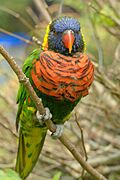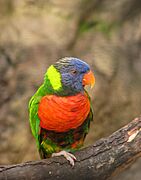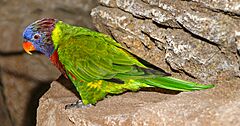Coconut lorikeet facts for kids
Quick facts for kids Coconut lorikeet |
|
|---|---|
 |
|
| Conservation status | |
| Scientific classification | |
| Genus: |
Trichoglossus
|
| Species: |
haematodus
|
The coconut lorikeet (Trichoglossus haematodus), also known as the green-naped lorikeet, is a colorful parrot. It belongs to the Psittaculidae family. Scientists used to group seven different types of lorikeets under this one name. Now, they are recognized as separate species.
Contents
Understanding the Coconut Lorikeet's Name
The coconut lorikeet got its scientific name, Trichoglossus haematodus, from Carl Linnaeus in 1771. He was a famous scientist who named many plants and animals. The name haematodus comes from an ancient Greek word meaning "blood-red." This refers to the red colors on the bird's chest.
For many years, this bird was called the rainbow lorikeet. But now, the name "rainbow lorikeet" is used for a different species found in Australia. Scientists have studied these birds closely. They found that several types of lorikeets are actually different species.
Different Types of Coconut Lorikeets
There are six recognized types, or subspecies, of the coconut lorikeet. They live in different areas.
- T. h. haematodus: This type lives in the southern Moluccas, islands near New Guinea, and along the west and north coasts of New Guinea.
- T. h. massena: You can find this one in eastern New Guinea, Karkar Island, the Bismarck Archipelago, the Solomon Islands, and Vanuatu.
- T. h. nesophilus: This subspecies lives on Ninigo and Hermit Islands.
- T. h. flavicans: This type is found on New Hanover and the Admiralty Islands.
- T. h. deplanchii: Also called Deplanche's lorikeet, it lives on New Caledonia and the Loyalty Islands.
- T. h. nigrogularis: This type is found on Kai and Aru Islands, and southern New Guinea.
The official common name for this bird is "coconut lorikeet." This name was chosen by the International Ornithologists' Union.
What Does a Coconut Lorikeet Look Like?
Coconut lorikeets are about 25 to 30 centimeters (10 to 12 inches) long. They weigh between 109 and 137 grams (about 4 to 5 ounces). Their beak is orange-red. The top of their head is dark blue, which fades to brown on their neck. They have a bright yellow collar around their neck.
Their upper body is green. The chest is red with blue-black stripes. Their belly is green with yellow stripes. The tail is green on top and has green and yellow stripes underneath. Male birds have bright red eyes. Female birds have orange-red eyes.
Where Do Coconut Lorikeets Live?
You can find Trichoglossus haematodus in eastern Indonesia. They live on islands like Buru, Seram, Misool, Waigeo, Numfoor, Yapen, and the Aru Islands. They also live in Papua New Guinea on New Guinea itself. Other places include the Bismarck Archipelago, the Solomon Islands, Vanuatu, and New Caledonia.
These birds live in many different places. They can be found in lowlands and wooded hills. This includes mangrove forests, rainforests, swamps, and savannas. They also live in places changed by people, like coconut farms, gardens, and disturbed forests. They can live from sea level up to about 2,440 meters (8,000 feet) high. The highest altitude depends on the specific location.
How Do Coconut Lorikeets Live?
Coconut lorikeets have a special tongue. It has a small brush-like tip. This brush helps them drink nectar and collect pollen from flowers. Nectar and pollen are their main foods. They also eat other parts of flowers, seeds, fruits, berries, insects, and insect larvae. When they fly, they often make loud, screeching calls. These calls sound like "peaow-peaow-peaow."
Family Life and Nesting
Coconut lorikeets are monogamous birds. This means they choose one partner and stay with them for their whole lives. They are active during the day. They live in very large groups. In the evening, these groups gather in a special "dormitory tree" to sleep.
These birds can breed for most of the year. However, they usually breed in the spring, from July to December. They typically raise one group of babies each year, sometimes two.
Their nests are usually in holes in old, decaying wood. They often choose hollows in eucalyptus trees. These nests are usually high up, about 25 meters (82 feet) above the ground. The female bird lays two matte white, round eggs. She sits on them for 23 to 25 days until they hatch. Both parents feed the chicks for 7 to 8 weeks. After that, the young birds leave the nest. They become fully independent about 2 to 3 weeks later.
Predators
Birds of Prey
- Peregrine Falcons: Known for their incredible speed, they are a major threat to lorikeets in flight, especially when the lorikeets are commuting between feeding and nesting sites.
- Brown Goshawks and Collared Sparrowhawks: These agile forest hawks are adept at hunting birds among trees, making them a significant danger.
Reptiles
- Pythons: These large, constricting snakes are expert climbers. They can easily access tree hollow nests to consume eggs, nestlings, and even incubating adults.
- Monitor Lizards (Goannas): Like pythons, goannas are powerful climbers and are notorious nest raiders, consuming eggs and young birds.
Mammals
- Rats (Black Rat, Brown Rat): Highly invasive and agile, they are devastating predators of eggs and nestlings in tree hollows.
- Feral Cats: They will stalk and prey on adult lorikeets, especially when they are feeding on low-flowering trees or on the ground.
- Possums (both native and introduced, like the Common Brushtail Possum) will raid nests for eggs and chicks.
- Quolls (native cat-like marsupials) are capable predators of birds and their nests.
Gallery







